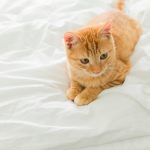1. Decoding the Ingredients List
Understanding the ingredients list on a cat food label is essential for choosing a high-quality diet for your feline friend. While some brands use premium ingredients, others may include fillers and artificial additives that provide little nutritional value. By learning how to read and interpret these labels, you can make informed decisions about what goes into your cat’s bowl.
Identifying High-Quality Protein Sources
Cats are obligate carnivores, meaning they require animal-based protein to thrive. Look for whole meat sources such as chicken, turkey, salmon, or beef listed as the first ingredient. Avoid vague terms like “meat by-products” or “animal meal,” as these can contain lower-quality protein sources.
| High-Quality Proteins | Lower-Quality Proteins |
|---|---|
| Chicken, Turkey, Salmon, Beef | Meat By-Products, Animal Meal |
| Duck, Lamb, Tuna | Poultry By-Products, Fish Meal |
Avoiding Fillers and Unnecessary Additives
Some cat food brands use fillers to bulk up their products without adding real nutritional value. Common fillers include corn, wheat, and soy, which can be difficult for cats to digest. Additionally, watch out for artificial preservatives like BHA and BHT, as well as artificial colors and flavors that serve no real benefit to your pet’s health.
Common Fillers to Watch Out For:
- Cornmeal
- Soybean Meal
- Wheat Gluten
- Poultry Digest
The Importance of Whole Ingredients
The best cat foods prioritize whole ingredients over processed alternatives. Instead of vague terms like “animal fat,” look for named sources such as “chicken fat” or “salmon oil,” which provide essential fatty acids beneficial for skin and coat health.
2. Understanding Guaranteed Analysis
When choosing the best cat food, understanding the guaranteed analysis on the label is essential. This section breaks down what the percentages of protein, fat, fiber, and moisture mean and how they impact your cat’s overall health and nutrition.
What Is Guaranteed Analysis?
The guaranteed analysis provides a breakdown of key nutrients in the cat food. It lists the minimum amounts of protein and fat, as well as the maximum amounts of fiber and moisture. These values help you compare different brands and formulas to ensure youre providing balanced nutrition for your cat.
Key Nutrients in Guaranteed Analysis
| Nutrient | Purpose | Typical Range |
|---|---|---|
| Protein | Essential for muscle growth, maintenance, and overall health. | 30%-40% (dry food), 8%-12% (wet food) |
| Fat | Provides energy and supports skin and coat health. | 10%-20% (dry food), 2%-6% (wet food) |
| Fiber | Aids digestion and prevents hairballs. | 1%-5% |
| Moisture | Keeps your cat hydrated and supports kidney function. | <10% (dry food), ~75% (wet food) |
How These Nutrients Impact Your Cat’s Health
Protein
Cats are obligate carnivores, meaning they require a diet rich in animal-based protein. High-protein diets support muscle maintenance, immune function, and overall vitality.
Fat
A healthy amount of fat provides essential fatty acids that support brain function, skin health, and a shiny coat. However, too much fat can lead to obesity, so balance is key.
Fiber
A moderate amount of fiber aids digestion and helps reduce hairballs. Too much fiber can interfere with nutrient absorption, while too little may cause digestive issues.
Moisture
Cats have a low thirst drive, so moisture-rich foods help keep them hydrated. Wet food is an excellent choice for maintaining urinary tract health and preventing dehydration-related issues.
Selecting the Right Balance for Your Cat
The ideal nutrient balance depends on factors like age, activity level, and any existing health conditions. Kittens need higher protein levels for growth, while senior cats may require lower-fat diets to prevent weight gain. Always consult your veterinarian if youre unsure about the best diet for your feline friend.
![]()
3. Recognizing Essential Nutrients
Understanding the essential nutrients in your cat’s food is key to ensuring their overall health and well-being. Cats have specific dietary needs that must be met through a balanced diet. Let’s take a closer look at some of the most important nutrients your feline friend requires.
Taurine: A Must-Have for Cats
Taurine is an essential amino acid that cats cannot produce on their own, meaning it must come from their diet. It plays a vital role in heart function, vision, and immune system health. Without enough taurine, cats can develop severe health issues, including blindness and heart disease.
Fatty Acids: Supporting Skin, Coat, and Brain Health
Fatty acids, such as omega-3 and omega-6, are crucial for maintaining healthy skin, a shiny coat, and proper brain function. These fats also help reduce inflammation and support joint health. Here’s a quick comparison of the two:
| Type of Fatty Acid | Benefits | Sources |
|---|---|---|
| Omega-3 | Supports brain function, reduces inflammation, promotes heart health | Fish oil, flaxseed oil |
| Omega-6 | Aids skin and coat health, supports immune function | Poultry fat, sunflower oil |
Vitamins: Essential for Overall Health
Cats need a variety of vitamins to stay healthy. Some of the most important include:
- Vitamin A: Supports vision and immune function.
- B Vitamins: Help with energy production and nervous system health.
- Vitamin D: Essential for calcium absorption and bone strength.
- Vitamin E: Acts as an antioxidant to protect cells from damage.
- Vitamin K: Helps with blood clotting.
Selecting a Nutrient-Rich Cat Food
The best way to ensure your cat gets all these essential nutrients is by choosing high-quality commercial cat food that meets AAFCO (Association of American Feed Control Officials) standards. Look for labels that specify complete and balanced nutrition to meet your cat’s dietary needs.
4. Identifying Marketing Gimmicks
When choosing the best food for your cat, it’s important to look beyond the flashy packaging and buzzwords. Many pet food brands use clever marketing tactics to make their products seem healthier than they actually are. Understanding these tricks will help you make informed decisions based on real nutritional value rather than misleading claims.
Common Marketing Terms and What They Really Mean
Some terms on cat food labels sound impressive but may not have any real impact on your cat’s health. Here are a few common ones:
| Marketing Term | What It Really Means |
|---|---|
| “Natural” | This means the ingredients come from natural sources, but it doesn’t guarantee that the food is free from unhealthy additives or fillers. |
| “Grain-Free” | Avoiding grains can be beneficial for some cats, but grain-free foods often replace grains with other carbohydrates like potatoes or peas, which may not always be better. |
| “Human-Grade” | This suggests the ingredients meet human food standards, but there is no official regulation enforcing this term in pet food. |
| “Veterinarian-Recommended” | This could mean only a small number of vets were consulted; it does not necessarily indicate broad veterinary approval. |
| “Premium” or “Gourmet” | No official standard defines these terms. They are used mainly for marketing purposes. |
The Importance of Reading the Ingredient List
The ingredient list provides a clearer picture of what’s really in your cat’s food. The first few ingredients should include high-quality protein sources like chicken, turkey, or fish. Avoid foods that list vague terms like “meat by-products” or “animal digest,” as these can be lower-quality protein sources.
Avoiding Artificial Additives
Cats don’t need artificial colors, flavors, or preservatives in their diet. Ingredients like BHA, BHT, and ethoxyquin are synthetic preservatives that may have potential health risks. Instead, look for natural preservatives like mixed tocopherols (a form of vitamin E).
How to Spot Genuine Nutritional Benefits
A truly nutritious cat food will have clear labeling about its protein content, essential vitamins, and minerals. Look for AAFCO (Association of American Feed Control Officials) statements on the packaging, as these indicate that the food meets basic nutritional requirements for cats at different life stages.
The Bottom Line on Marketing Gimmicks
The best way to choose a healthy cat food is to focus on the ingredient list and guaranteed analysis rather than flashy words on the packaging. By understanding these marketing tactics, you can ensure youre feeding your cat a diet that truly supports their health and well-being.
5. Choosing the Best Food for Your Cat’s Needs
When selecting the right food for your cat, its essential to consider their age, health conditions, and lifestyle. Cats have different dietary needs depending on these factors, so choosing a well-balanced diet tailored to their specific requirements will help them stay healthy and happy.
Understanding Your Cat’s Life Stage
Cats go through different life stages, and each stage requires specific nutrition. Here’s a breakdown of what to look for:
| Life Stage | Nutritional Needs |
|---|---|
| Kitten (0-12 months) | High protein and fat content for growth, DHA for brain development |
| Adult (1-7 years) | A balanced diet with protein, fats, vitamins, and minerals |
| Senior (7+ years) | Easily digestible protein, joint support supplements, lower calories if less active |
Catering to Health Conditions
If your cat has specific health concerns, you may need to choose specialized food formulated to support their condition. Some examples include:
- Weight management: Low-calorie food with high fiber to keep them full
- Sensitive stomach: Limited ingredient diets or foods with prebiotics and probiotics
- Kidney disease: Low-phosphorus and low-protein diets designed for kidney support
- Urinary tract health: Formulas that promote hydration and balance urinary pH levels
- Allergies: Hypoallergenic or grain-free diets based on individual sensitivities
Lifestyle Considerations
Your cats activity level also plays a role in determining the best diet. Indoor cats tend to be less active and may require fewer calories, while outdoor or highly active cats might need more energy-dense food.
| Lifestyle Type | Nutritional Considerations |
|---|---|
| Indoor Cats | Lower calorie food to prevent weight gain, added fiber for hairball control |
| Outdoor/Active Cats | Higher calorie food with more protein and fat for sustained energy levels |
| Sedentary or Overweight Cats | Diets with lower fat content and higher fiber to maintain a healthy weight |
The Importance of Hydration in Your Cat’s Diet
Cats naturally have a low thirst drive, which is why incorporating moisture-rich foods like wet canned food can help maintain proper hydration levels. If feeding dry kibble, ensure your cat has constant access to fresh water.
Selecting the Right Food Format: Wet vs. Dry Food
The choice between wet and dry food depends on your cat’s preferences and nutritional needs:
| Food Type | Pros | Cons |
|---|---|---|
| Wet Food (Canned) | – Higher moisture content – More palatable for picky eaters – Supports urinary health |
– Shorter shelf life once opened – Can be more expensive |
| Dry Food (Kibble) | – Convenient and cost-effective – Helps with dental health – Longer shelf life |
– Lower moisture content – Some formulas may contain more carbohydrates |
| A Combination of Both | – Provides variety – Balances hydration and convenience |
– Requires portion control to prevent overeating |
Consulting Your Veterinarian for Guidance
If youre unsure about the best diet for your cat, consulting your veterinarian is always a good idea. They can recommend a suitable diet based on your cat’s unique health profile and nutritional needs.
Selecting the right cat food involves understanding your pet’s life stage, health conditions, and lifestyle. By reading labels carefully and choosing high-quality ingredients tailored to their needs, you can provide the best possible nutrition for your feline companion.


